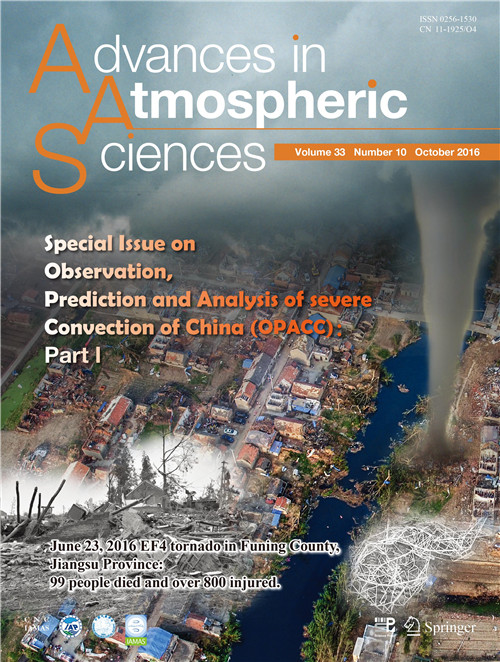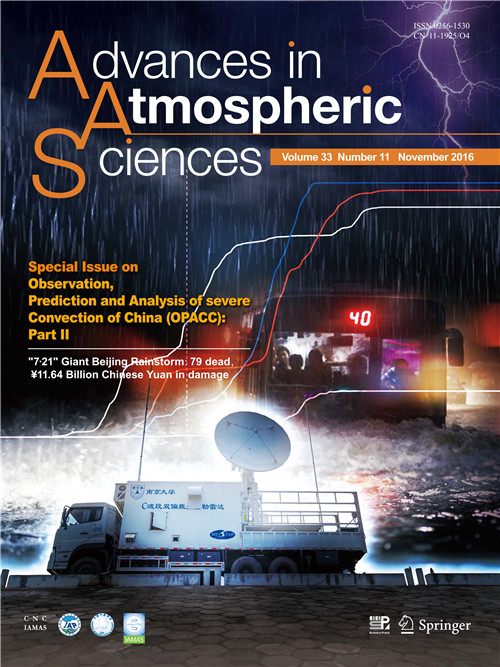AAS Publishes Special Issue Research Collection on Severe Weather Research in China
Date:2016-10-20
Severe weather is becoming more and more frequent around the globe. Often, the difference between minor property damage or something far more devastating is the ability to predict a storm in the first place, especially when it comes to the short-lived but severe variety.
Advances in Atmospheric Sciences (AAS) – an international journal sponsored by the Institute of Atmospheric Physics of the Chinese Academy of Sciences and published by Springer – organized a special collection of 16 original papers spanning the October and November 2016 issues. The Special Issue covers severe convection subjects ranging from extreme precipitation climatology, data assimilation, numerical simulation and prediction, radar observation, and analyses for convective weather, as well as a study on tornadic events. The Special Issue is now available at SpringerLink (Part I: http://link.springer.com/journal/376/33/10 ; Part II: http://link.springer.com/journal/376/33/11 ).
“Severe convective storms are intense local phenomena. Research on such phenomena requires high-resolution observational networks, and high-resolution numerical simulation and prediction tools, as well as researchers well trained on the subject,” said Ming XUE, one of the Editors-in-Chief of the journal, a professor of meteorology and the director of the Center for Analysis and Predictions of Storms at the University of Oklahoma.
XUE is also an adjunct professor at the School of Atmospheric Sciences at Nanjing University, and serves as the principal scientist of Ministry of Science and Technology (MOST) project “Observation, Prediction and Analysis of severe Convection of China (OPACC)”. The five-year venture was started in 2013, and has more than $5 million in funding from MOST. Nanjing University took the lead of the project and Other members include the Institute of Atmospheric Physics, Peking University, the National Meteorological Center, the Nanjing University of Information Science and Technology, Lanzhou University, Zhejiang University, and the Beijing Institute of Urban Meteorology.

The cover of Part I of the Speical Issue is designed based on the photos taken by Prof. Ming XUE during his investigation in Funing County on June 26, 2016. A tornado struck Funing County, east China's Jiangsu Province, on June 23, 2016, accompanied by torrential rain, Death toll from extreme has climbed to 99. (Credit: AAS)

The cover of Part II of the Speical Issue features "721" Giant Beijing Rainstorm in the Beijing area on 21 July 2012. Also shown on the cover is a photo of the mobile C-band dual-polarimetric radar of Nanjing University, which is capable of accurately measuring rainfall and microphysics. The curves show the accumulated rainfall predicted by some of the 4-km ensemble members at the station location where maximum accumulated rainfall was measured on that day. (Credit: AAS)
“For the past decade, rapid progresses have been made in establishing modern, integrated meteorological observation systems in China,” XUE said, who also pointed out the availability of mobile research weather radars and other instruments needed to study convective storms. “The time was right to carry out systematic and organized research on convective storms, with the goal of improving the prediction skills of such weather systems.”
XUE hopes that the special issue of Advances in Atmospheric Sciences will heighten awareness regarding convective weather research associated with the OPACC project, as well as potentially attract more scientists to collaborate in future research endeavors.
